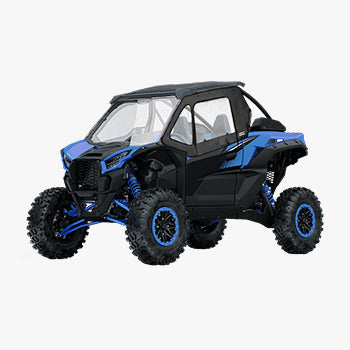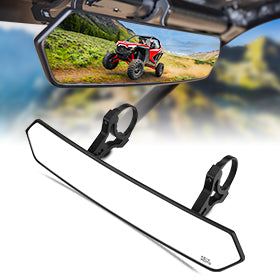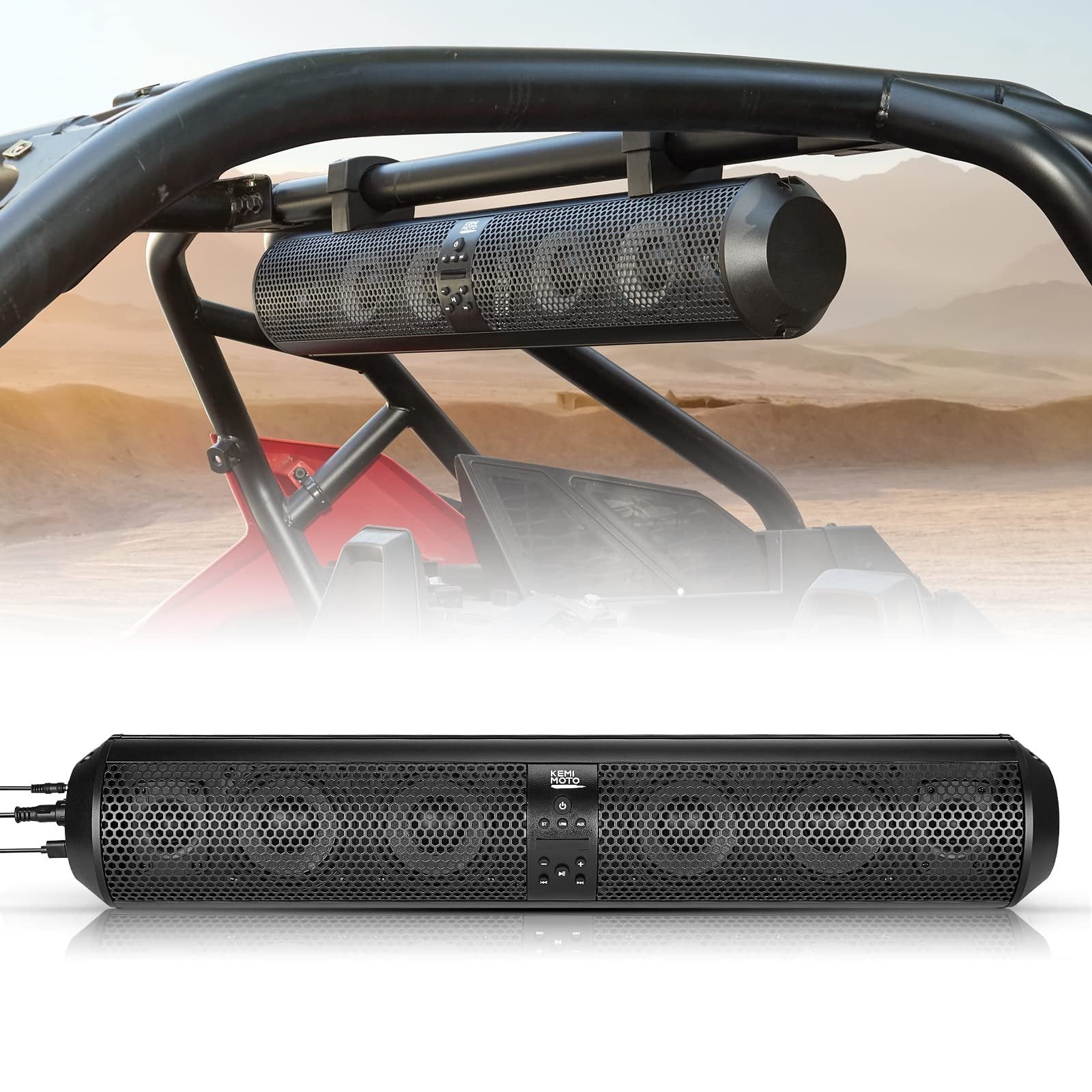Polaris Ranger vs. RZR: Which Is Better?

When it comes to quality off-road vehicles, the Polaris Ranger and Polaris RZR 4 1000 stand out among the crowd as two of the highest-quality UTVs on the market today.
Both of these vehicles boast exceptional power and durability and are some of the most versatile UTVs, well-suited for a diverse array of outdoor adventures. Whether you’re looking to conquer challenging rocky trails, navigate steep inclines, or traverse deep mud pits, both of these impressive UTVs promise an exhilarating high-performance experience coupled with top-notch comfort, handling, and power.
Of course, with both of them being such outstanding options, trying to pick the perfect one for your needs can be quite a conundrum. Luckily, you’ve come to the right place.
Come with us as we take a deep dive into the Polaris Ranger and RZR 4 1000 models to explore their features, capabilities, and overall performance so you can get started with your next off-road adventure right away!
- Side-By-Side Comparison
- Polaris Ranger Pros And Cons vs. RZR
- When To Use Polaris Ranger vs. RZR
- Final Thoughts
Side-By-Side Comparison
|
2022 Polaris Ranger 1000 |
2022 Polaris RZR XP 1000 |
|
|
Starting MSRP |
$14,999 |
$25,999 |
|
Weight |
1,437 pounds |
1,633 pounds |
|
Horsepower |
61 HP |
114 horsepower |
|
Engine |
99cc twin-cylinder four-stroke SOHC |
999cc parallel-twin engine |
|
Towing Capacity |
2,500 pounds |
1,500 pounds |
|
Tires |
Carlisle tires; 210mm dual-hydraulic disc brakes |
29 x 9-14 and 29 11x14 Radial tires |
|
Suspension |
Dual A-Arm Suspension |
20.5” front and rear suspension |
Polaris Ranger Pros And Cons vs. RZR

Polaris RZR 4 1000 Pros
The main reason we love the Polaris RZR 4 1000 so much is that it’s remarkably comfortable. The vehicle offers seating for up to four riders, complete with adjustable headrests and seat belts, delivering a comfortable ride on even the most challenging of terrains.
The Polaris RZR 4 1000 stands up well to just about any trail, thanks to its outstanding off-road capabilities. You get a killer four-wheel drive system, extended-travel suspension, and impressive ground clearance, perfect for rugged terrain adventures.
Lastly, the Polaris RZR lineup is known for its remarkable customizability. Similar to the Ranger, the expansive Polaris aftermarket community provides endless opportunities to personalize your vehicle.
Polaris RZR 4 1000 Cons
One of the main problems with RZRs is that they suffer from radiator blockages.
Unfortunately, the RZR 4 1000's radiator lacks adequate protection, leaving it vulnerable to dirt and debris clogs. This issue can be especially troublesome when dealing with mud, which has a tendency to accumulate in the front of the radiator grille. In turn, overheating is something many RZR owners run into.
Having to pull over and clear the grille all the time can be pretty annoying.
Polaris Ranger 1000 Pros
If one of your main reasons for getting a UTV is to do work around the yard or farm, then the Polaris Ranger stands out as the superior choice. Polaris offers a super versatile Ranger lineup, including a two-seater model for those seeking a compact ride and a six-seater model designed to accommodate larger work crews effectively.
With the top model delivering up to a whopping 82 HP, you get ample power to navigate rugged terrains while carrying heavy loads. Of course, it doesn’t top out the speed of the RZR, but it’s still relatively tough compared to most UTVs in the same range.
Some of our favorite features of the Polaris Ranger include true AWD (All-Wheel Drive), power steering, an impressive 12" ground clearance rating, and a generous 10 inches of suspension travel, ensuring seamless travel across even the most challenging of landscapes.
Depending on the model you opt for, you'll be capable of towing loads ranging from 1,500 to 2,500 pounds. Beyond that, you have the option to attach a cargo box to your chosen model, giving you an extra 1,000 pounds of hauling power.
Lastly, we can’t leave without highlighting the ergonomic aspects of this UTV. Thanks to the spacious door area and low-step entrance, getting in and out of the Ranger is a hassle-free experience. Top that off with recently enhanced plush seats and tilt steering, and you can guarantee a smooth and comfortable ride, no matter where you are.
Polaris Ranger 1000 Cons
The Polaris Ranger has some notable drawbacks when handling uneven terrain, especially when compared to the Polaris RZR. It suffers from reduced ground clearance at two inches lower, and its Pro-Lock All-Wheel Drive system doesn't efficiently transfer power to the front wheels when you start slowing down.
This can make it more prone to sliding off the road, particularly in wet or icy conditions.
Moreover, the Polaris Ranger offers fewer add-on features compared to its RZR counterpart. This limited range of trim options can restrict your customization choices.
When To Use Polaris Ranger vs. RZR

1. Location
Both the Polaris Ranger and the Polaris RZR were designed for off-road adventures, making them well-suited for navigating challenging terrains like desert dunes, mountain trails, or rugged wooded areas.
Nevertheless, due to its enhanced speed and agility, the Polaris RZR excels more on open terrains and racetracks, and you can feel the performance difference right away.
Conversely, the Polaris Ranger truly shines in long-distance rides, thanks to its ultra-comfortable cabin.
2. Comfort
Both UTVs provide pretty solid comfort levels.
If you really want the smoothest possible ride on rough and uneven trails, the Polaris Ranger is the superior choice. There’s a reason why so many people use it as a daily driver.
However, in terms of how comfortable the interior is, both the Ranger and the RZR offer ample cargo space and spacious interiors. You’ll find relatively broad entrances and generously proportioned plush seating, making them an ideal choice for larger riders or those with storage needs.
3. Reliability
In terms of overall reliability, it’s hard to pick a distinct frontrunner, as Polaris maintains a consistent level of reliability across all its UTV models.
What’s essential to highlight, however, is that each of these models is accompanied by an unrestricted six-month limited warranty, which covers factory-related issues.
4. Fuel Economy
Fuel efficiency can vary depending on how you use your UTV, though it’s certainly worth looking at overall fuel economy if you're a budget-conscious rider.
The Polaris Ranger comes with a 9.5-gallon fuel tank, while the RZR comes with a 13-gallon tank. In terms of general fuel economy, reports from users commonly indicate that their Rangers get around 17.7 miles per gallon, whereas others report that their RZRs get anywhere from 10-15.
5. Customizability
Polaris has long been known for its exceptional commitment to customization options. Whether you want to attach a spacious cargo box for transportation or equip your UTV with a snow plow for driveway maintenance, both of these vehicles deliver an impressive degree of customization opportunities.
Final Thoughts

Polaris has been a longstanding industry leader in the UTV world, which is why trying to decide between these two exceptional vehicles can be difficult.
One of the first things we recommend considering is your primary purpose of usage.
If you’re in the market for a UTV for work-related tasks, the Polaris Ranger 1000 is a better choice. However, if fun and recreational activities are more your speed, we recommend the Polaris RZR.
Whatever terrains you’re going to venture into, make sure to check out our wide range of Polaris accessories here at Kemimoto to make your Polaris ride better!









Leave a comment